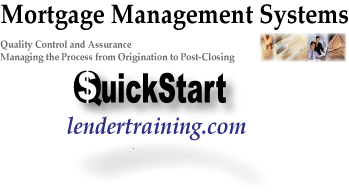|
|
|||||||||||||||||||||||||||||||||||||||||||||||
|
November 13, 2009 - "News You Can Use" Having trouble reading this document? Download on-line at http://quick-start.net/mortgageprofessional.htm |
|||||||||||||||||||||||||||||||||||||||||||||||
|
Speak now, or forever hold your peace Yield Spread Premium rules
approach end of comment period
Executive Summary Federal Reserve Proposals In July, 2009, the Federal Reserve Board proposed changes to the mortgage provisions of the Truth in Lending Act (TILA). The proposal would limit the payment of yield spread
premiums to originators The current practice of disclosing all loan terms on a product specific disclosure would continue. Recognizing some beneficial uses, the proposal does not ban the practice of compensating mortgage brokers through the interest rate but intends to put limits on the more abusive uses of yield-spread premiums. Straight commission based on fee revenue would be banned. Compensation based on loan volume, the performance of loans delivered by an originator or hourly wages is permissible under the proposal. A consideration is whether the rule should allow compensation based on the loan amount. The Fed's latest proposal would ban incentive payments to all loan originators - mortgage brokers or bank loan officers. The massive proposal is out for comment until December 24, 2009. Click here to review If you would like to comment you should be specific in your comment. We recommend stating that your consumers are already confused by duplicative disclosures, and that the GFE proposal is already provides the information delivered in the proposed changes. A second closing cost and yield spread disclosure would create more challenges for the home-buying public. Advocate for the abandonment of multiple disclosures in favor of ONE SINGLE UNIFORM DISCLOSURE. Respond HERE HUD and Federal Reserve Coordinating Similar to the HUD rule going into effect 1/1/10, the proposed rule requires a flat fee stated upfront that cannot be increased by changes in the loan terms. The Fed is working with HUD to make the TILA and RESPA mortgage disclosures more compatible and possibly merge them. If the Consumer Financial Protection Agency is authorized, the Obama administration will develop a uniform mortgage disclosure. Temporary Buydowns - Is this really the kind of product that created the Mortgage Meltdown?... At QuickStart we have been going through the process of getting our courses approved through the NMLS. We were surprised by some of the reviewer's comments on what we feel are common treatments of loan programs, but none as much as those referring to the use of temporary buydowns. In today's climate the temporary Buydown (2-1 or 1-0) is a program that allows payment rate reduction for qualifying purposes on a fixed rate loan. It is one of the few remaining tools loan originators have to help borrowers with difficulty in qualifying. What objection could a regulator really have with regard to this product? The negative feature of a temporary Buydown is that payments are going to increase. This raises the specter of payment shock. However, unlike any other changing rate product -such as adjustable rate mortgages -the payment changes are predictable and much smaller than potential changes on interest rate capped adjustable rate mortgages. In fact, a 2% increase in interest rate would result in a payment that changes by nearly 20%, whereas the Buydown Payment only increases by 9%. The amount of additional income required to maintain parity with the Buydown payment increase (based on a 28% qualifying ratio) is only 2.5%-3%, less than what many cost of living adjustments are.
As an originator, we want to be able to balance the needs of a borrower who has increasing income but whose current income does not allow them to meet his or her housing needs. We cannot simply arbitrarily increase the amount of a borrower's loan, but if we can use a factually accurate approach, the temporary Buydown can help meet a family's needs. For a free lesson on temporary buydowns, please register for FREE TRAINING - we have two sites Resource Based Training Catalog - www.quick-start.net/freetrainingregistration.htm - Online Training Catalog - http://www.ezlcms.com/v2/login/897/catalog.asp |
NMLS National and State Test Preparation Programs On-Line Programs
Loan Officer/Processor Training - Books, Manuals and on-line Training - 2009 Versions Now Available!
Production Managers - FREE Training Site for basic introductory information
Looking for Lending Policies and Procedures? Complete customizable templates
Red Flag ID Theft Program Required by 5/1/09
|
||||||||||||||||||||||||||||||||||||||||||||||
|
QuickStart Quality Control Systems and Mortgage Training Programs 1 Research Court, Suite 450 Rockville, MD 20850 301-738-7031 - Office 877-91-TRAIN - Toll Free 877-729-4033 - Fax
|
All Material Copyright 2009 QuickStart Publications visit:
|
||||||||||||||||||||||||||||||||||||||||||||||
| © 2009 QuickStart/MortgageManuals.com/Lendertraining.com | |||||||||||||||||||||||||||||||||||||||||||||||



